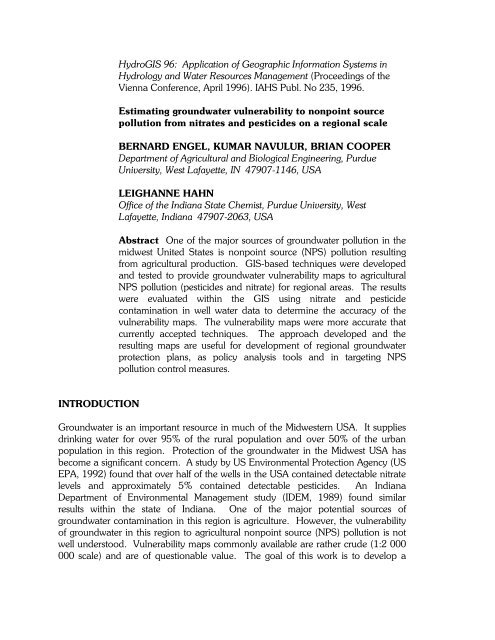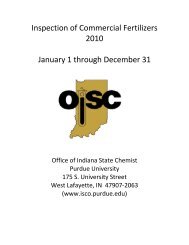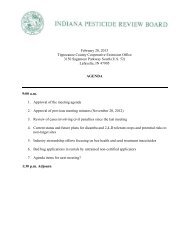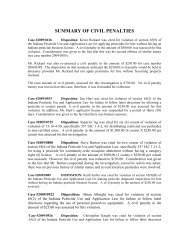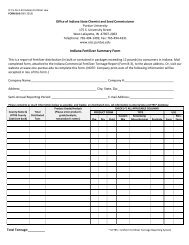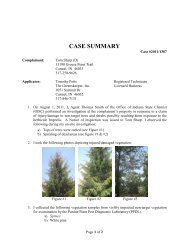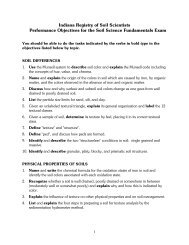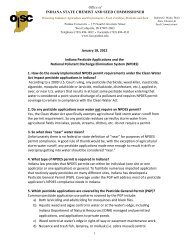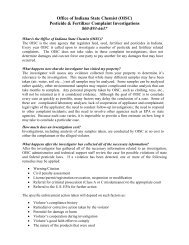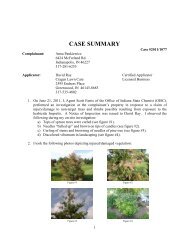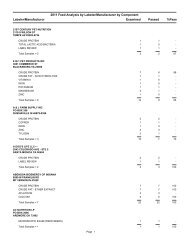Estimating groundwater vulnerability to nonpoint source - Office of ...
Estimating groundwater vulnerability to nonpoint source - Office of ...
Estimating groundwater vulnerability to nonpoint source - Office of ...
- No tags were found...
Create successful ePaper yourself
Turn your PDF publications into a flip-book with our unique Google optimized e-Paper software.
identified in several cases in the study area as being responsible for observed nitratedetections.The DRASTIC, SEEPAGE, and SPISP results were compared with well moni<strong>to</strong>ringdata that had been analysed for pesticides. Two detection databases were used – onecompiled by the US Geological Survey and one compiled by the Farm Bureau.Approximately 400 wells were sampled in the USGS dataset and 860 wells in the FarmBureau dataset with more than 90% <strong>of</strong> the wells falling in the medium and high<strong>vulnerability</strong> categories for all three indices. Pesticides were detected in approximately 9%<strong>of</strong> the wells in the USGS data and approximately 15% <strong>of</strong> the wells in the Farm Bureau data.Figures 3 and 4 show the distribution <strong>of</strong> pesticide detections by each <strong>of</strong> the indices. For allthree indices, most <strong>of</strong> the pesticide detections fall within the moderate and high <strong>vulnerability</strong>categories. The SPISP index performs the best, although DRASTIC and SEEPAGE alsoseem reasonable. It is interesting <strong>to</strong> note that SEEPAGE predicts low <strong>vulnerability</strong> forapproximately 20 detections in the Farm Bureau data. These areas deserve additionalattention <strong>to</strong> understand why pesticides are being detected in these locations whileSEEPAGE predicts these areas <strong>to</strong> have low vulnerabilities <strong>to</strong> such occurrences.The DRASTIC, SEEPAGE, and SPISP approaches for predicting <strong>groundwater</strong><strong>vulnerability</strong> performed reasonably well for both nutrients and pesticides. The mapsresulting from these indices are being used <strong>to</strong> target <strong>groundwater</strong> protection efforts. Areaspredicted <strong>to</strong> have moderate, high and very high vulnerabilities are being investigated inmore detail. Additional moni<strong>to</strong>ring wells are being installed using the <strong>vulnerability</strong> maps <strong>to</strong>target wells in areas suspected <strong>to</strong> have higher vulnerabilities. Approaches that betterconsider fac<strong>to</strong>rs important <strong>to</strong> <strong>groundwater</strong> contamination but not considered in the simpleindices used are being used in combination with GIS <strong>to</strong> refine estimates <strong>of</strong> <strong>vulnerability</strong>.REFERENCESAller, L., Bennett, T., Lehr, J. H. & Petty, R. J. (1985) DRASTIC: a standardized systemfor evaluating <strong>groundwater</strong> pollution potential using hydrogeologic settings. US EPA,Robert S. Kerr Environmental Research Labora<strong>to</strong>ry, Ada, Oklahoma, EPA/600/2-85/0108.Aller, L., Bennett, T., Lehr, J. H., Petty, R. J. & Hackett, G. (1987) DRASTIC: astandardized system for evaluating <strong>groundwater</strong> pollution potential using hydrogeologicsettings. EPA-600/2-87-035.ESRI (1992) ARC/Info User’s Guide. ESRI, California.Goss, D. & Wauchope, R. (1992) The SCS/ARS/CES Pesticide Properties Database: IIUsing it With Soils Data In a Screening Procedures, USDA Research Article. USDA,Washing<strong>to</strong>n, DC.IDEM (1989) Groundwater Section, Indiana Groundwater Protection, A Guide Book.Indiana Department <strong>of</strong> Environmental Management, Indianapolis, Indiana.
Navulur, K., Cooper, B. S. & Engel, B. A. (1995) Groundwater <strong>vulnerability</strong> evaluation <strong>to</strong>pesticide pollution on a regional scale using GIS. Paper no 953617, ASAE, St. Joseph,Michigan.Richert, S. E., Young, S. E. & Johnson, C. (1992) SEEPAGE: a GIS model for<strong>groundwater</strong> pollution potential. Paper no. 922592. ASAE, St. Joseph, Michigan.US EPA (1992) Another look: national survey <strong>of</strong> pesticides in drinking water wells phase IIreport. EPA 579/09-91-020. EPA Washing<strong>to</strong>n, DC.
Table 1 Comparison <strong>of</strong> conventional DRASTIC ratings with observed nitrate detections.Observed Low Moderate High Very HighLow 25 146 138 0Moderate 1 17 63 0High 0 2 18 2Very high 0 2 2 1Table 2 Comparison <strong>of</strong> conventional SEEPAGE ratings with observed nitrate detections.Observed Low Moderate High Very HighLow 9 183 117 0Moderate 2 22 57 0High 0 2 20 0Very high 0 2 3 0Table 3 Comparison <strong>of</strong> modified DRASTIC ratings with observed nitrate detections.Observed Low Moderate High Very HighLow 86 85 138 0Moderate 6 11 63 0High 0 1 20 1Very high 0 2 2 1


